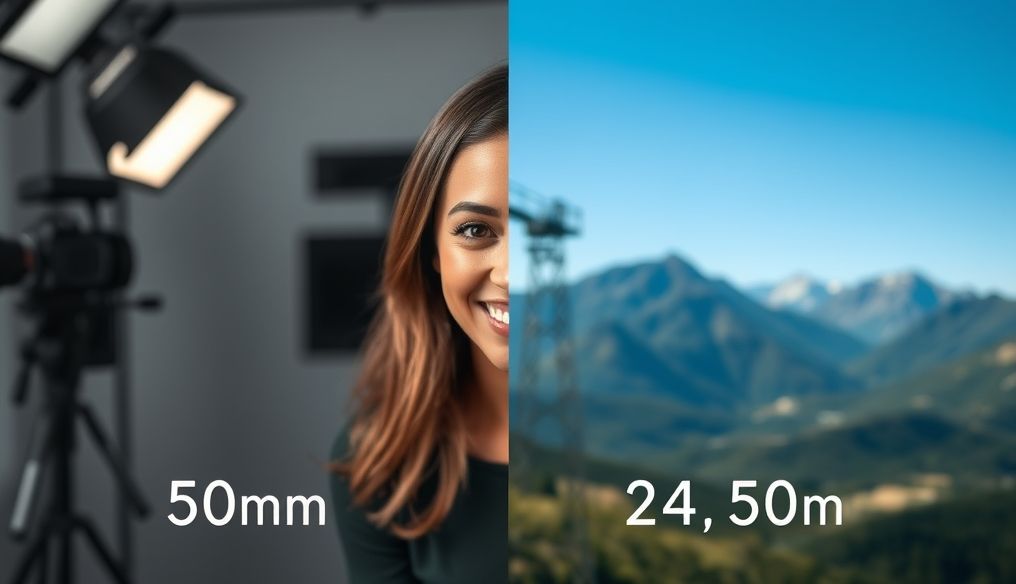What is the difference between "Prime" and "Zoom" lenses and how do you choose the best one for you?
In the world of photography, the lens is a crucial element in determining the quality of the final image. Lenses vary, but the most prominent are "Prime" and "Zoom" lenses. Understanding the difference between them helps you choose the right lens for your needs.
What are Prime Lenses?
Prime lenses, also known as fixed lenses, are lenses with a fixed focal length. This means they cannot zoom in or out. For example, a 50mm lens is a prime lens.
Advantages of Prime Lenses:
- Superior Image Quality: Prime lenses generally have higher image quality compared to zoom lenses. This is because they are designed to achieve maximum sharpness and clarity at a single focal length.
- Wide Aperture: Prime lenses are often capable of achieving a wider aperture (such as f/1.4 or f/1.8). This allows more light to enter the camera, making them ideal for shooting in low-light conditions and creating shallow depth of field effects (bokeh).
- Smaller Size and Lighter Weight: Prime lenses are usually smaller and lighter than zoom lenses, making them easier to carry and use for extended periods.
- Lower Price: In many cases, prime lenses are cheaper than zoom lenses of similar quality.
Disadvantages of Prime Lenses:
- Lack of Flexibility: Since they have a fixed focal length, you must physically move closer to or further away from the subject. This can be inconvenient or impossible in some situations.
- Need for Multiple Lenses: To cover a variety of scenes, you may need to purchase several prime lenses with different focal lengths.
What are Zoom Lenses?
Zoom lenses are lenses with a variable focal length. This means they can zoom in or out to change the angle of view. For example, a 24-70mm lens is a zoom lens.
Advantages of Zoom Lenses:
- Flexibility: Zoom lenses offer great flexibility in framing images. You can change the angle of view without having to move.
- Convenience: A single zoom lens can replace several prime lenses, reducing the need to constantly switch lenses.
- Versatility: Zoom lenses are suitable for a wide range of photography types, from landscapes to portraits.
Disadvantages of Zoom Lenses:
- Lower Image Quality: In general, the image quality of zoom lenses is slightly lower than that of prime lenses.
- Narrower Aperture: Zoom lenses often have a narrower aperture than prime lenses, reducing their ability to shoot in low-light conditions.
- Larger Size and Heavier Weight: Zoom lenses are usually larger and heavier than prime lenses.
- Higher Price: High-quality zoom lenses can be more expensive than prime lenses.
Detailed Comparison between Prime and Zoom Lenses:
| Feature | Prime Lenses | Zoom Lenses |
|---|---|---|
| Image Quality | Higher | Lower (Generally) |
| Aperture | Wider | Narrower (Generally) |
| Size and Weight | Smaller and Lighter | Larger and Heavier |
| Flexibility | Lower | Higher |
| Price | Lower (Generally) | Higher (Generally) |
| Usage | Specialized | Versatile |
When to Choose a Prime Lens?
Choose a prime lens if you:
- Are looking for the best possible image quality.
- Need a wide aperture for shooting in low-light conditions or creating shallow depth of field effects.
- Prefer a small and lightweight lens.
- Have a limited budget.
- Specialize in a specific type of photography, such as portraits or street photography.
When to Choose a Zoom Lens?
Choose a zoom lens if you:
- Need flexibility in framing images.
- Want a single lens that can cover a variety of scenes.
- Don't mind sacrificing image quality slightly for convenience.
- Shoot landscapes, sports events, or wildlife.
Tips for Choosing the Right Lens:
- Determine your budget: Lens prices vary greatly. Decide how much you are willing to spend before you start looking.
- Consider the type of photography you do: What types of photos do you take most often? Do you need a wide-angle lens for landscapes or a telephoto lens for wildlife?
- Read reviews: Before buying any lens, look for reviews from other photographers. This can give you a good idea of the lens's performance.
- Try the lens: If possible, try the lens before buying it. This will help you determine if it is right for you.
- Don't be afraid to start with a basic lens: If you are a beginner, don't feel pressured to buy the most expensive lens. Start with a basic lens and learn the basics of photography before investing in more expensive lenses.
Conclusion:
Both prime and zoom lenses have their advantages and disadvantages. The best choice for you depends on your needs, budget, and shooting style. If you are looking for the best possible image quality and focus on a specific type of photography, a prime lens may be the best choice. If you need flexibility and convenience, a zoom lens may be the best choice. Ultimately, the best way to determine the right lens for you is to try it out yourself.
Statistics and Figures:
- Statistics show that professional photographers often prefer prime lenses for their high image quality in portraits and studio shots.
- Studies show that zoom lenses are more common among amateur photographers due to their flexibility and versatility.
Practical Example:
Imagine you are shooting a wedding. You may need a zoom lens to capture candid moments from afar, but you may also need a prime lens with a wide aperture to capture portraits in low-light conditions.
Practical Tip:
If you are unsure which lens to choose, start with a 50mm f/1.8 lens. It is a cheap and high-quality prime lens that is perfect for learning the basics of photography.




